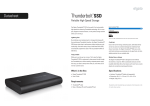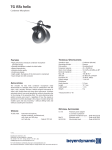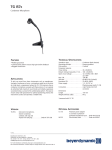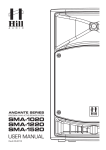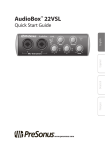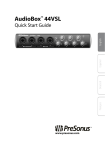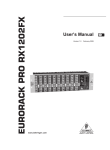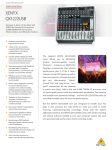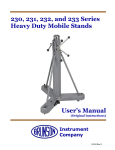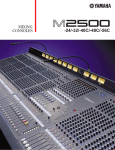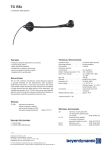Download Tascam US-122 User's Manual
Transcript
Applications Guide 06/30/03 Page 1 of 4 US-122 US-122 Compact USB Audio/MIDI Interface ˘ USB audio/MIDI computer interfacing ˘ Mac and Windows compatible ˘ Two XLR-fed phantompowered mic inputs with inserts ˘ Two line/guitar level inputs T he TASCAM US-122 creates a compact, portable bridge between your music and your computer, whether you’re recording using microphones, guitars or MIDI synthesizers. Two great-sounding, highheadroom Tascam microphone inputs allow you to record the most challenging vocal or musical sources. These mic inputs feature professional Neutrik® XLR connectors and switchable phantom power, which means they’re ready for any microphone you can throw at it. ˘ 16 channels of MIDI I/O ˘ Adjustable zero-latency direct monitoring ˘ Two line outputs with level control ˘ Headphone output with level control ˘ Self-powered via USB: perfect for both studio and location recording ˘ Includes ASIO, WDM, GSIF and Apple Core Audio (OS X) drivers ˘ Includes Cubasis VST 8-track audio recording/ MIDI sequencing software ˘ Includes GigaStudio 24 sampling workstation software ˘ Compact and rugged die cast aluminum construction ˘ Dimensions: 149mm(H) x 60mm(W) x 196mm(D) ˘ Weight: 925g In addition, you get W" balanced line inputs, with selectable guitar level, for compatibility with anything in your studio from guitars and basses to VCRs and drum machines. Each channel gives you a hefty level knob, signal and overload lights to make setting levels a snap. You also get an insert point on each channel for patching in hardware gear such as compressors, gates and EQs. For better performances when overdubbing, the US-122 features zero-latency Direct Monitoring. (See the sidebar on Direct Monitoring for more information). Twenty-four-bit resolution at 44.1kHz or 48kHz ensures better-thanCD-quality recording. On the output side, the US-122 includes line outs and a W" headphone out – each with individual level controls – so you don’t need to switch off your speakers to work on headphones. Synthesizers and samplers can be patched in using the MIDI input and output. And you’ll want to connect your MIDI gear with the included GigaStudio™ 24 software, the world’s biggest, best-sounding sampler, and a special copy of Steinberg’s® Cubasis™ software. The included drivers work with Mac® or PC computers, and add support for ASIO, WDM, GSF, Sound Manager and Apple Core Audio (OSX) software standards. Since the US-122 is powered through the USB cable, you wont need a wall-wart power supply to use it with a laptop when inspiration strikes on the road. And if you hit any bumps in the road, you’ll appreciate the US-122’s solid, steel chassis and robust construction. With exceptional sound quality, professional analog inserts, 16-channel MIDI I/O and zero latency direct monitoring, it’s clear the US-122 is the ideal tool for capturing your creative musical ideas into your computer. 06/30/03 Page 2 of 4 US-122 Applications Guide Home Recording A simple USB cable and the US-122 transform any desktop Mac or PC into a recording workstation. You don’t need to crack open your computer and wrestle with PCI cards to add audio and MIDI recording hardware and software to your computer anymore. And the controls are all on the top panel for quick, easy adjustments. The US-122 has switchable phantom power and XLR microphone inputs, allowing you to record using highquality condenser microphones. In the studio pictured above, a pair of condenser mics are set up to record vocals and guitar while monitoring through headphones. When you’re finished recording, you can easily switch back to speakers thanks to the individual headphone and line controls. best-sounding sampler. In fact, since the US-122 is GSIFcompatible, it’s your best solution for using GigaStudio on a laptop. The US-122 also includes Steinberg’s Cubasis VST software, so you’ll be ready to record in minutes without buying extra software. Monitors Line Out USB Synthesizer MIDI Computer Phones Headphones The MIDI inputs and outputs allow you to connect synthesizers, drum machines, synchronizers, lighting controllers, and hundreds of other musical tools. By plugging a synthesizer into the MIDI input, you’ll be able to use GigaStudio, the world’s most powerful and, Microphone Microphone Mic Input L Mic Input R Recording on the Road T he US-122’s design makes it ideal for use with laptop computers, so you can carry your professional studio around in a backpack. With its rocksolid, die-cast aluminum chassis and robust, compact design, you instantly know that the US-122 was built for the road. And since it’s powered by the USB connection, that’s one less wall-wart power supply you need to cart around or lose. The US-122’s Direct Monitor feature gives you the flexibility to record and overdub without suffering with latency delay. You’ll easily record layer after layer into the bundled Cubasis VST software, crafting your musical ideas into finished productions. (See the sidebar on Direct Monitoring for more information.) The line inputs of the US-122 can be switched to guitar level, so you can plug in direct without any extra baggage. And with 24-bit, 48kHz recording quality, your late night motel room sketches might just make it on to your next album. USB Phones Headphones Computer Guitar Microphone Mic Input L Guitar Input R 06/30/03 Page 3 of 4 US-122 Applications Guide Video Editing and Multimedia Production S ure it’s called Motion Picture, but good storytelling often comes from unique sound design. This is where the US-122 can make the perfect addition to your video editing or multimedia creation suite. Just plug it into a free USB port to add high-quality, low noise sound playback to any editing system. Its tiny footprint fits on even the most cluttered video production workspace. The pro studio mic preamps are ideal for recording a strong voiceover, whether it’s just for the rough cut or for your final product. You’ll also appreciate having a mic available to add a sound effect, or even to record a musical soundtrack. The built-in insert jack allows you to plug in outboard processing like compressors and EQ so you won’t need to re-record your voiceover in post production. Monitors Line Out USB Phones Computer Headphones Microphone Compressor Mic Input L Insert L What is Direct Monitoring? W hen you record a signal into your computer, it goes through a few steps. First you set the mic or line input level.Then it’s converted into digital audio,which gets sent through the USB connection to your computer, where it needs processing before it reaches the recording software. When this signal is played back, it has to go through the whole journey in reverse. (See Figure 1.) And as fast as modern computers are, this process isn’t instantaneous. Figure 1. Speaker when you’re “overdubbing”, punching in changes to a segment, or recording another layer over what you’ve already recorded. It’s because of this delay that we added Direct Monitoring to the US-122. This feature allows you to hear what your recording before the signal makes it’s journey to the computer and back. (See Figure 2) Since you’re bypassing the computer, there’s no delay in your headphones. You even get a separate level control for the Direct Monitor, and a Mono switch to sum the two channels together. Even if you’re still unclear about Direct Monitoring, you’ll understand the first time you try to record without it. Computer Figure 2. Microphone Speaker US-122 This means that anything you record would have a slight delay before it reaches your headphones or speakers. Even though it’s only a few thousandths of a second, this delay (also called latency) can be distracting when you’re making music. This delay is even more apparent Computer Microphone US-122 Applications Guide US-122 Connections ˘ Two Mic Inputs with Neutrik® XLR connectors ˘ Switchable Phantom Power ˘ Two W" TRS Balanced Line Inputs ˘ Guitar/Line level switch per channel ˘ MIDI Input ˘ MIDI Output ˘ USB Jack ˘ W" Stereo Headphone Jack ˘ Two W" TRS Insert Jacks ˘ Two RCA Line Outputs System Requirements Mac: ˘ Mac with built-in USB port ˘ PowerMac 604e 200MHz processor (PowerMac G3 266 MHz recommended) ˘ 128MB RAM (192MB recommended) ˘ Mac OS 8.6 through X (Cubasis is not Mac OS X compatible) Windows: ˘ Available USB port ˘ Intel Pentium II, AMD Duron or better ˘ 128MB RAM, 192MB for Windows 2000 or XP ˘ Windows 98, Windows 98 SE, Windows ME, Windows 2000, Windows XP 7733 Telegraph Rd • Montebello, CA • 90640 • phone 323.726.0303 • www.tascam.com © 2003 TEAC Corporation All trademarks are the property of their respective holders. All rights reserved. Design and specifications subject to change without notice. Product photographs are shown only to illustrate the types of product which are compatible with the TASCAM US-122 Computer Interface. These products are not manufactured by the TASCAM Division of TEAC Corporation. 06/30/03 Page 4 of 4 US-122




